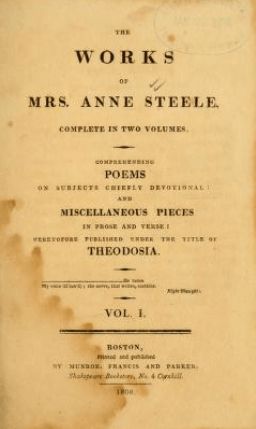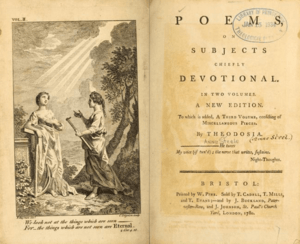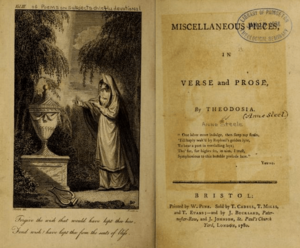Anne Steele facts for kids
Quick facts for kids
Anne Steele
|
|
|---|---|
| Born | 1717 Broughton, Hampshire, England |
| Died | 11 November 1778 Broughton |
| Resting place | St John the Baptist's Church cemetery |
| Pen name | Theodosia |
| Occupation | hymnwriter, essayist |
| Language | English |
| Nationality | British |
| Subject | Christianity |
| Signature | |
Anne Steele (who used the pen name Theodosia) was an English Baptist hymnwriter and essayist. She lived from 1717 to 1778. For about 100 years after she died, her hymns were sung more often in churches in the United States and Britain than those of any other woman.
Anne loved reading and writing from a young age. She often wrote poems to entertain her friends. As she grew older, she became very religious and loved sacred literature. This led her to write many pieces, both poems and essays. She published these works using the pseudonym "Theodosia." This means she used a fake name to hide her true identity.
Because she used a pen name, Anne was not widely known outside her friends. But parts of her spiritual poems quickly became popular in different collections. In 1760, two books of her work were published. They were called Poems on Subjects chiefly Devotional, by Theodosia. After she died in 1778, a new edition came out with an extra book. This collection included 144 hymns, 34 Psalms written as poems, and about 30 short poems. Her hymns were first used in church services in 1769. Many of her original works are kept at the Baptist College in Bristol.
Contents
Anne Steele's Early Life and Writing Journey
Anne Steele, also known as "Nanny," was born in Broughton, Hampshire, England, in 1717. Her family had a long history of being Puritans. Her father, William Steele, was a minister for a Baptist community. Anne showed a strong religious interest early on. When she was 14, she joined the church where her father was the pastor.
Because of an accident when she was a child, Anne was often sick. She spent a lot of time in her room. This quiet time allowed her to focus on her writing. She loved poetry and often shared her works with friends. However, she was very shy about letting the public read her writings.
Her father's diary shows that Anne first sent her writings to be printed in 1757. Both her father and stepmother admired her talent. But they also wanted her to remain humble about her abilities. It wasn't until she was 44 years old that she agreed to have her hymns published for public use.
In 1760, she published Poems on Subjects Chiefly Devotional under her pen name, Theodosia. This book was so popular that a second edition was printed in 1780. Later, all her works were put into one book in 1863. This collection included 144 hymns, 34 psalms, and 50 other poems. Some of her hymns, like "Father of mercies, in Thy word," are still sung in many churches today. She is sometimes compared to Frances Ridley Havergal, another famous hymn writer.
Anne also wrote missionary hymns before modern missionary groups even existed. She even wrote a well-known Sunday school hymn before Sunday schools were common.
Anne Steele's Quiet Life
Anne Steele loved her quiet home in Hampshire. She preferred a peaceful life. She once wrote about enjoying a calm evening and wishing she could describe the beauty of spring. But she also thought about how quickly these beautiful things would disappear. This made her mind turn to thoughts of heaven, a place of lasting joy and perfection.
Anne was often sick and preferred to stay at home. For many years, she was confined to her room due to illness. During this time, she wrote many religious essays, both in prose and poetry.
In 1769, Anne's father passed away. It is said that she never fully recovered from this loss. After his death, she lived for nine more years in her brother William's house. His house was built very close to their old family home. Unlike many writers of her time, Anne had enough money to donate the profits from her books to religious and charity causes. Her family continued this tradition after she died.
No pictures of Anne Steele were ever made. She died in her hometown on November 11, 1778, at the age of 62. She was buried in her family's burial place at Broughton Church cemetery.
What Anne Steele Wrote About
Anne Steele's hymns were very popular, especially among Baptists. Her hymns often focused on the more serious parts of Christian life. She is considered one of the most important Baptist hymn writers. This is true whether you look at how many of her hymns were used in the 1800s or how often they were sung.
Her hymns were usually simple to understand. They used natural and pleasant images. They were also full of true Christian feelings. Anne Steele's hymns showed a deep personal devotion to Jesus. She often wrote about His suffering.
Selected works
- Poems on subjects chiefly devotional, 2 volumes
- Miscellaneous Pieces in Verse and Prose by Theodosia
- The works of Mrs. Anne Steele
See also
- English women hymn-writers (18th to 19th-century)
- Eliza Sibbald Alderson
- Augusta Amherst Austen
- Sarah Bache
- Charlotte Alington Barnard
- Sarah Doudney
- Charlotte Elliott
- Ada R. Habershon
- Katherine Hankey
- Maria Grace Saffery
- Emily Taylor
- Emily H. Woodmansee





